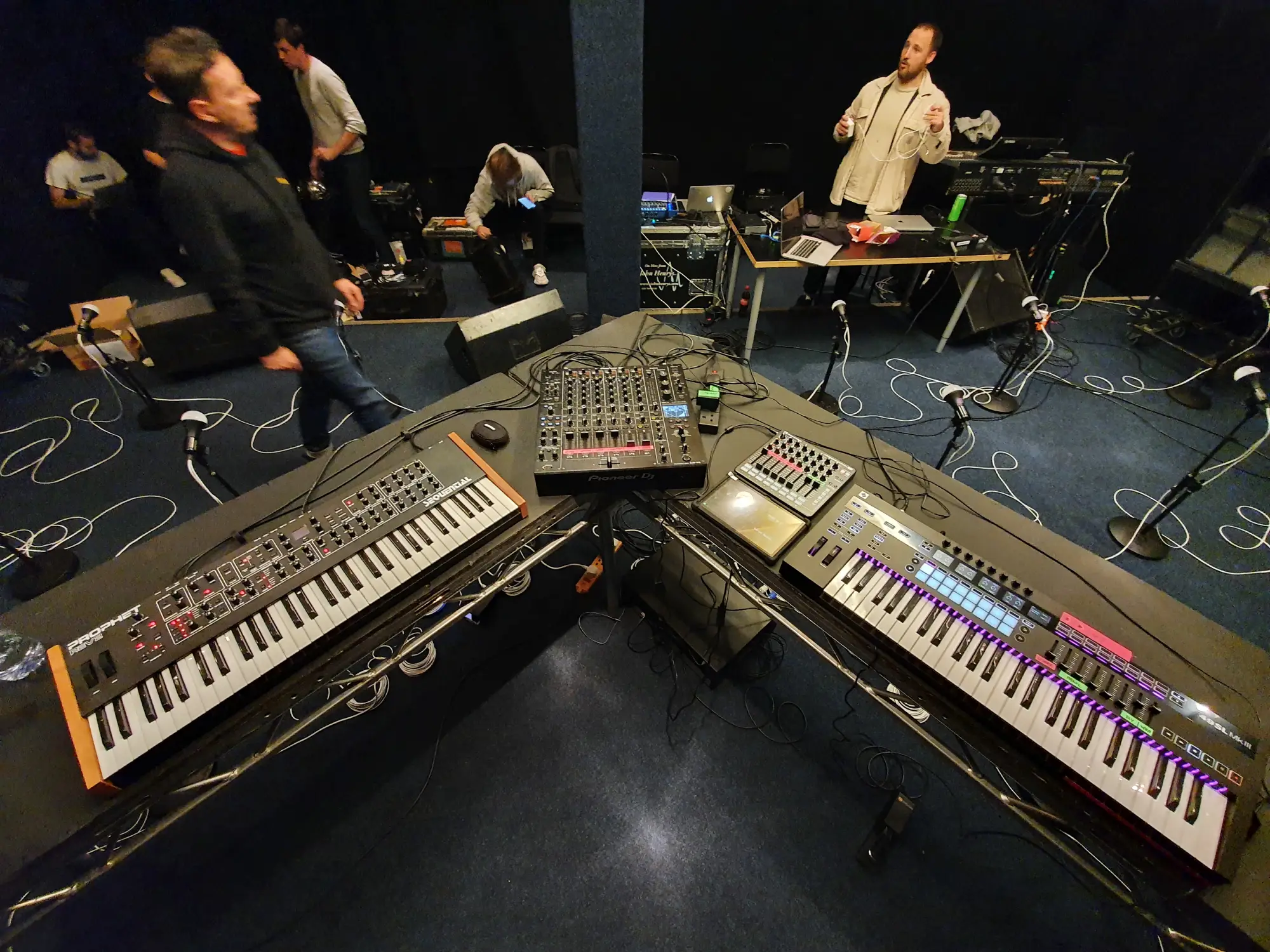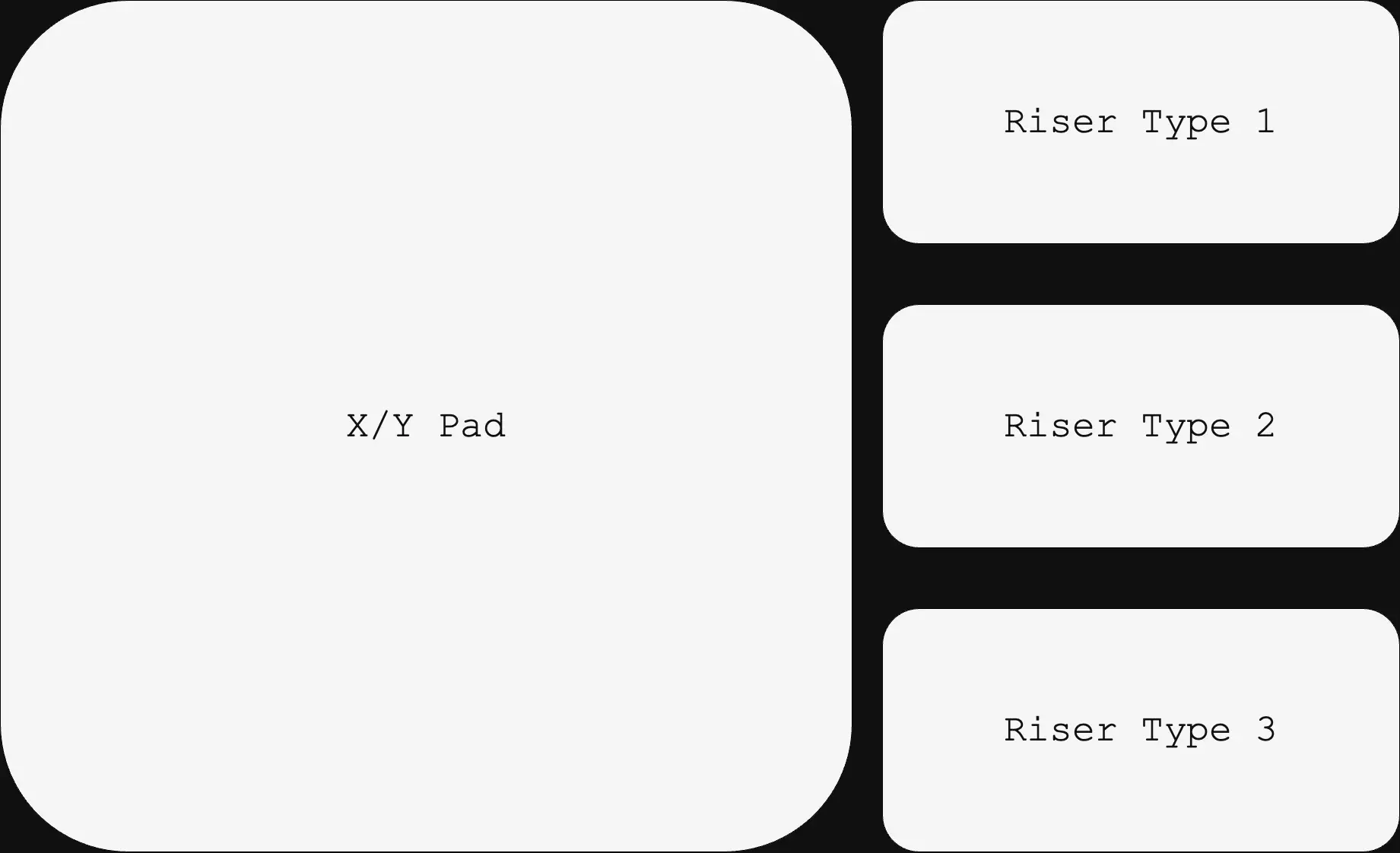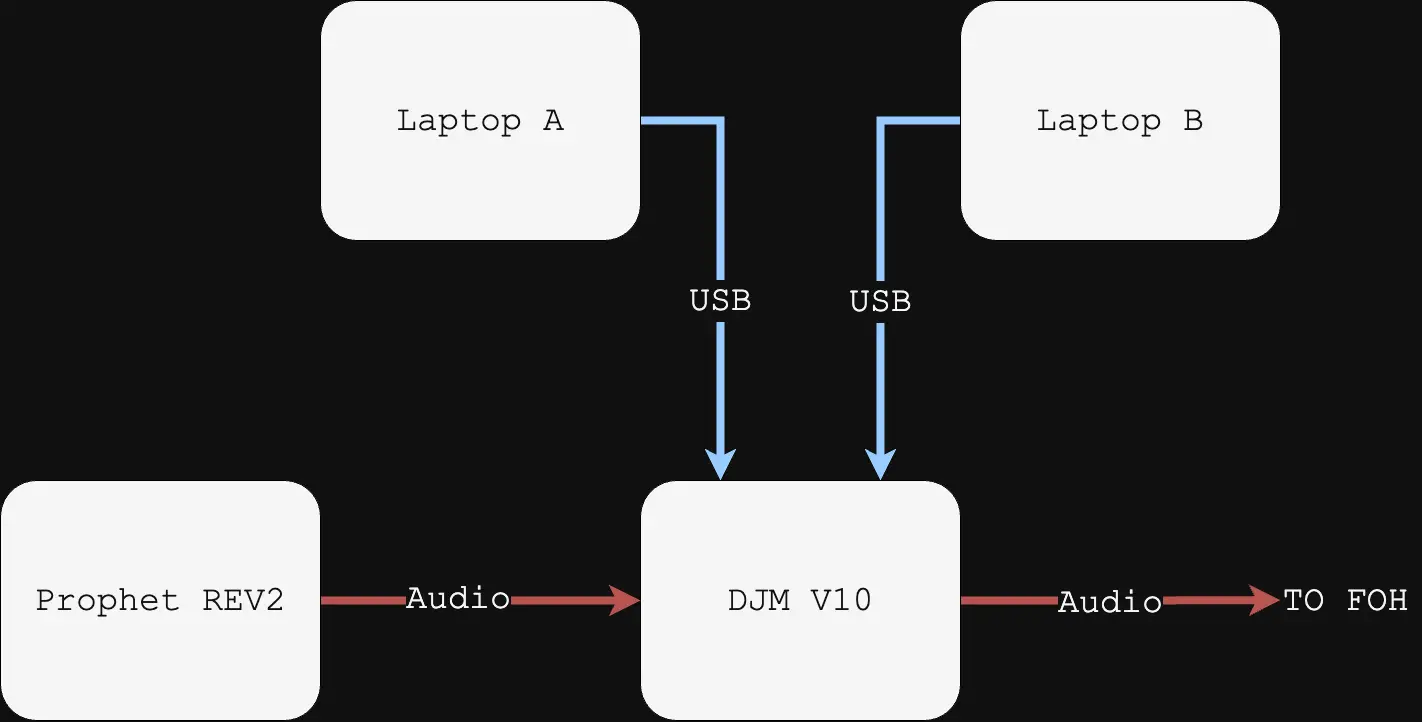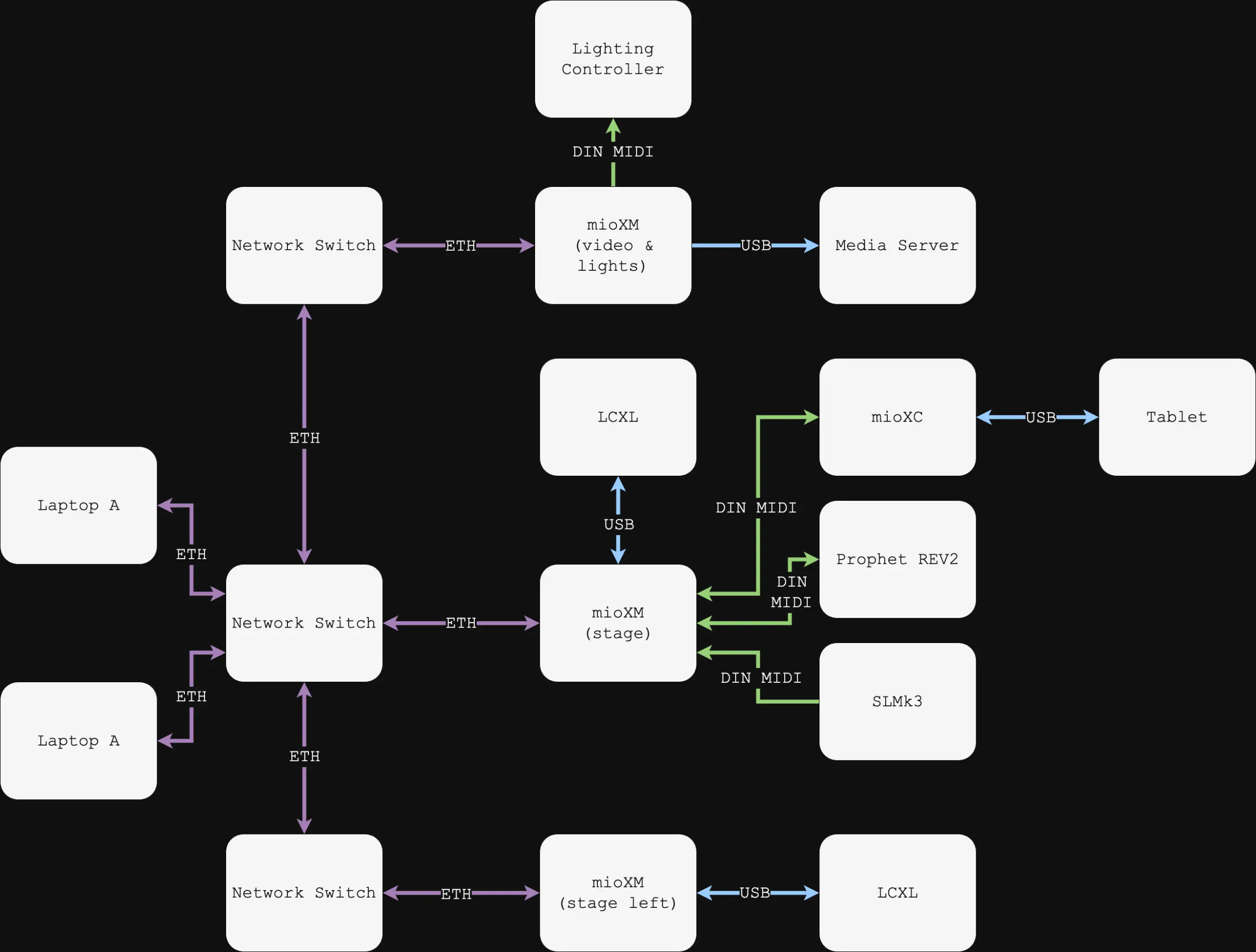
This is the first in our series of show write-ups. We’ll be looking to outline some key and unique parts of each artist’s show as well as run-downs on some of the technology behind it in separate articles. If you enjoy these or want to ask any questions you can email us at
contact [at] aworkinprogress.uk
Artist Brief
A low maintenance, high impact show that stands apart from other artists in the space. It must be able to tour without a Tour Manager, a small fly pack and minimal hire equipment. Ideally this show will break even on the first cycle.
DJ Seinfeld was new to performing Electronic Music in a live context so he was happy to take more guidance than usual on parts to recreate for the show. This tour will only be him on stage so we need to make the most of him as an individual performer.
Performance Environment & Tech
Artist POV:

DJ Seinfeld comes from a predominantly DJ background, in terms of this project, but like a lot of producers he grew up playing Piano. Information like this is key in making decisions on how and where in the show his parts will be played. It may seem glaringly obvious what we’ll start finding keyboard parts across his tracks for him to play but we also need to look closely at his current performances to find alternative techniques that will engage him for more than 1 track. The fact of the matter is that people who are having a good time on stage will radiate this energy to their audience who will in turn reciprocate this. Whenever we’re putting together a show we are looking to create an equilibirum of this energy transfer between the performers and audience to enhance the experience for everybody involved. This is where you get that ‘Holy shit that was a good show’ feeling consistently from gig to gig.
It would be naive to ignore where a producer/DJ’s initial writing process often comes from. They’re mostly in the box or with a synth tweaking some knobs until there’s a result that creates an atmosphere that can be explored. FX manipulation and performance is a core part of the making and should always be present in electronic shows. If you’re lucky, like we were on DJ Seinfeld Live, there’s a specific preset on a specific software native plugin that when controlled and manipulated live gives you an awesome FX performance that is also true to the sound of the record.
When thinking about the performance experience of an artist from this kind of background we need to move carefully in what is put in front of them on stage. Too much traditional playing may induce imposter syndrome about their ability regardless of their compentency but no playing at all will unblance the scales the other way and make the show feel like a fraudulent offering. We’re always looking for a balance to get an engaging representation of studiocraft as well as ‘traditional’ live techniques. On DJ Seinfeld’s show this was done by retaining a DJ mixer while introducing him to hardware synthesis and some novel FX and sound generation technologies.
To facilitate this we used the following…
Audio & Soundcard
- Pioneer DJM V10
MIDI, Networking & Control
- iConnectivity mioXM
- iConnectivity mioXC
- Novation LaunchcontrolXL
- Novation 49 SLMk3
- Cheap Android Tablet
- Netgear unmanaged 5 port Network Switch
Synths
- Sequential Prophet REV2
Software
- Ableton Live 11 Suite
- TouchOSC
Computers
- Apple M1 Macbook Pro 13
- 16GB RAM
- 1TB SSD
Why Use a DJ Mixer as a Soundcard?
The DJM V10 is an interesting product. It has 2 USB Audio interfaces which are quickly and easily switchable on each channel strip on the mixer. Each channel also has a very simple compressor making it far more appropriate for raw source audio. It also has a decent matrix of monitor sends.
It may already seem obvious to you that this piece of technology can support not only multitrack playback but also solve a quick wired IEM mix with a click track. This means we can take advantage of all the click and cue tricks to keep the show on track with lights and video but also give DJ Seinfeld the opportunity to manipulate stems with Pioneer DJ Mixer style FX. From the off this part of his performance environment will be familiar but with far more control over audio than he would have in his DJ performances. This small amount of augmentation generates excitement that the crowd will feed off. Even when we’re in a drum driven part of the show transitioning to the next track there’s still a lot of opportunities to be creating a unique moment of a track you already know.
In theory Pioneer is a global brand and a standard on DJ stages. This would suggest that aquiring a V10 on hire wherever we are in the world would be a simple task. I wish this was true but due to supply chain issues the reality of getting this mixer show to show wasn’t great. More than once we had to reprogram the show file to accomodate a DJM900 NXS2 and it was common on festival stages for stage managers to try and bully us out of using the V10 so it could be given to another artist. There’s an unfortunate reality in touring that being self contained is the only way to have a fully consistent show and in hindsight we should have purchased our own mixer at the beginning of the campaign to tour.
Is he just watching The Office on that cheap Tablet?
No. He did ask but unfortunately it’s being used as a MIDI controller.
We run TouchOSC on the Tablet with a custom patch. Initially we were going to use Lemur for this task but around the time we were building, Lemur was just being discontinued. In all honesty this was for the best. The UX and UI of TouchOSC is far superior to that of Lemur. It took all of about 40 mins on our first time opening the editor to create the patch we need, get it sending the correct MIDI and have it show ready. Lemur definitely took much longer in the past…
The purpose of this is to control a sampler, initially developed for the Gorgon City show(write-up coming soon!), to do very simple white noise risers on an X/Y pad. Tablets are very good at this kind of system, especially customising it. The end product looked something like the following…

It’s a simple system but super effective for adding to buildups and breakdowns.
Why a Prophet REV2?
We spent a lot of time trying to figure out what would be the right keyboard for DJ Seinfeld. Hardware synths add a huge amount of value to a show and we always advise you break out of the box and have at least 1. The journey you take from choosing the parts to programming the sounds inevitably takes you somewhere you didn’t expect and creates interesting sounds that help re-imagine the original record. As well as this you find some immediate performance techniques with high impact that make your show super engaging.
The track this really shone on in DJ Seinfeld’s show was ‘These Things Will Come To Be’. We chose the main sequenced chord part to recreate on the REV2 which we managed to do super quickly and easily. Giving DJ Seinfeld control of both the filter and release created a super exciting performance which was always a highlight in the show. With this control the part became much more unruly, the filter opened more, the release became longer than it needed to be and turned the whole part in to a wall of the chords. DJ Seinfeld could tailor these builds and drops to the room which worked consistently across the whole campaign.
How it all goes together…
Audio

MIDI & Data

Reflecting on what we did
This was our first proper show back after a long pandemic wondering what would happen next. The technology we can build this on has changed a huge amount since we sat in the studio sipping pale ales and figuring out what track came next in the set list. Apps such as AbleSet would definitely improve our playback control and minimise the gear we tour. There was potentially a better plug and play mixer solution, please email us if you have one, and we will develop control on fx and parts in later shows for sure. DJ Seinfeld is constantly developing as a musician and will undoubtly make different and more involved decisions in the next iteration of his show.
Ultimately live shows are a journey where musicians learn more about themselves and how they want to protray their brand than any other endeavour. The flexibility in this space is unmatched, for real you can get away with audio murder, and it should be used to your advantage. Your listener experience is no longer about plays or views or likes. Your snare doesn’t have to be perfect anymore, chances are most sound systems won’t do it justice anyway. Everybody who has bought a ticket and stood in line in the pouring rain to get in is your focus. That group of people who took the time to clear an evening in their schedule, convince their mates to come so they didn’t go on their own, buy tickets and be there to see the supports as well as you. Those people want to experience the music you made that they love with you and their experience was 25% of your record anyway.
Your show will transcend you so let it tell you what’s important and where to go next.